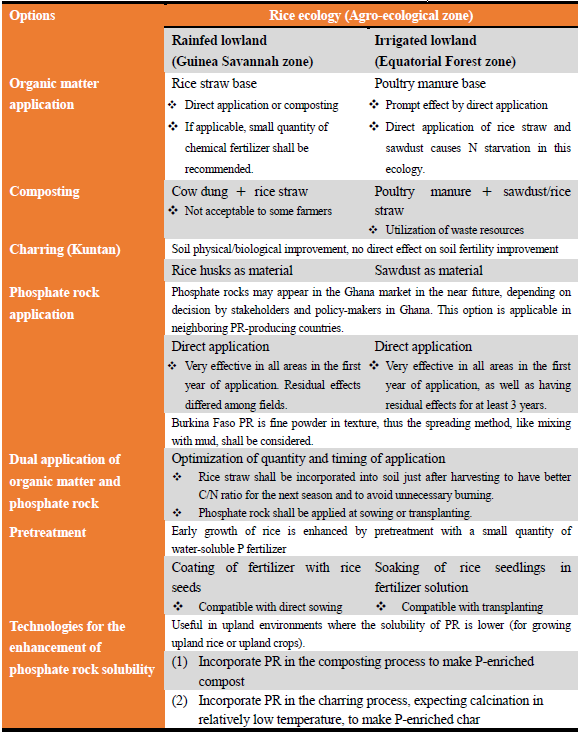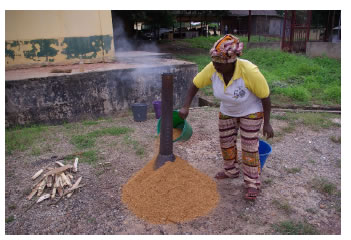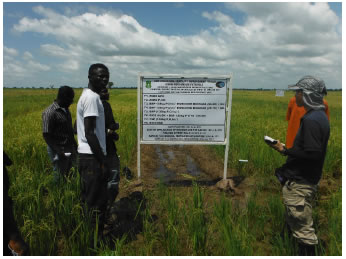Manual of soil fertility improvement technologies in lowland rice ecologies of Ghana
Description
The impact of fertilizer application on crop production in Sub-Saharan Africa (SSA) is considered enormous as the region is very low in soil fertility. However, access to chemical fertilizers is difficult especially for small-scale SSA farmers who do not have sufficient financial resources in a market-oriented economy. This crucial issue underscores the urgent need for the farmers to increase agricultural productivity, which can be achieved through inexpensive and cost-effective techniques of improving soil fertility in rural areas.
With financial support from the Ministry of Agriculture, Forestry and Fisheries (MAFF) of Japan, JIRCAS carried out a study on technology development for improved soil fertility using indigenous resources that are accessible and acceptable to local farmers. The study, with rice being the target crop, is aimed at contributing to the goal of the Coalition for African Rice Development (CARD) to double rice production in SSA by 2018. Ghana was selected as the country of implementation because it has two major rice ecologies (rainfed lowland and irrigated lowland) and has good research counterpart institutions.
As one of the products of the study, a technical handbook, titled “Manual of soil fertility improvement technologies in lowland rice ecologies of Ghana,” was published. Written in English, this manual would greatly benefit extension workers and assist them in disseminating the technologies to rice farmers. A summary of the manual’s features is listed below.
- The manual describes the application of indigenous organic matter as well as their composting and charring technologies, the application of phosphate rocks from neighboring Burkina Faso and its solubilizing technologies, and the enhancement of early rice growth using a minimum quantity of chemical fertilizer (Table 1).
- The technologies mentioned in the manual were developed in consideration of available materials in each rice ecology and corresponding region. The technologies were evaluated for effectiveness and affordability to the rural communities in on-farm participatory studies.
- Government officers as well as counterpart researchers in Ghana were actively involved in the editorial process, enhancing their sense of ownership of the manual and technologies. The foreword was written by the deputy minister of the Food and Agriculture (MoFA), Ghana.
- This manual is compact enough to be carried around. It is printed on A5 size paper and contains only 44 pages, with visually descriptive text and plenty of visuals (photographs and illustrations).
- The technologies adopted in the manual may be extended to other SSA countries having the same rice ecologies.
Figure, table
-
Table 1.Technology options adopted in the soil fertility manual
-
Fig. 1. Charring of saw dust (Kumasi City)
-
Fig. 2. Demonstration in an on-farm field (at Ziong Village, a suburb of Tamale City)
- Affiliation
-
Japan International Research Center for Agricultural Sciences Crop, Livestock and Environment Division
- Classification
-
Technical
- Research project
- Program name
- Term of research
-
FY 2014 (FY 2009-FY 2013)
- Responsible researcher
-
Tobita Satoshi ( Crop, Livestock and Environment Division )
KAKEN Researcher No.: 30450266Nakamura Satoshi ( Crop, Livestock and Environment Division )
KAKEN Researcher No.: 00749921Fukuda Monrawee ( Crop, Livestock and Environment Division )
Nagumo Fujio ( Crop, Livestock and Environment Division )
KAKEN Researcher No.: 20399372 - ほか
- Publication, etc.
-
Manual of soil fertility improvement technologies in lowland rice ecologies of Ghana
https://www.jircas.go.jp/ja/publication/manual_gudeline/29MANUAL of SOIL FERTILITY IMPROVEMENT TECHNOLOGIES in LOWLAND RICE ECOLOGIES of GHANA
Issaka et al. (2012) In “Soil fertility” InTech Press, Rijeka, Croatia, 119-134
https://doi.org/10.5897/AJAR12.1830Nakamura et al. (2013) African Journal of Agricultural Research, 8, 1779-1789.
https://doi.org/10.11648/j.aff.20140305.17Issaka et al. (2014) Agriculture, Forestry & Fisheries 3(5), 374-379.
- Japanese PDF
-
2014_B01_A3_ja.pdf179.48 KB
2014_B01_A4_ja.pdf271.59 KB
- English PDF
-
2014_B01_A3_en.pdf133.86 KB
2014_B01_A4_en.pdf534.8 KB
- Poster PDF
-
2014_B01_poster.pdf380.59 KB



